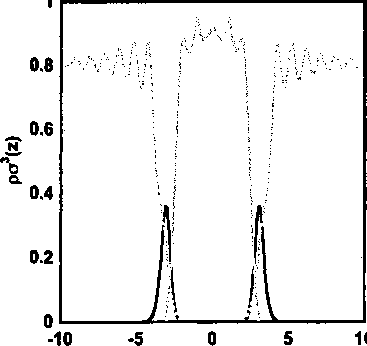is also purely repulsive while in the AA case it is uniformly attractive. The density
profiles of the head groups, tail groups and solvent molecules for these cases are
shown in figures 4.4a and b, respectively. The results are in good agreement with
the simulation results. Since the lipid molecules lose configurational entropy near the
surface, they push the solvent molecules near the surface. This is effectively captured
by the theory.

z∕σ
Figure 4.5: Modified iSAFT prediction for the lipid bilayer structure. The state point is
∕⅛σ3 = 0.68, xa = 0.442. The density profile of the head segments is shown in black, tail
segments in gray and solvent molecule in dashed gray curve.
Finally the theory is applied to study the structure of a lipid bilayer. The attrac-
tive interactions between the different segments are included to mimic the energetics
of real bilayer forming lipid molecules. Similar segments, head-head, tail-tail and
solvent-solvent, uniformly attract each other. In addition, a head segment uniformly
attracts the solvent segments, while the interactions between a tail and solvent seg-
ment and a head and tail segment, is purely repulsive. For the calculation, the com-
102
More intriguing information
1. The name is absent2. Centre for Longitudinal Studies
3. DISCRIMINATORY APPROACH TO AUDITORY STIMULI IN GUINEA FOWL (NUMIDA MELEAGRIS) AFTER HYPERSTRIATAL∕HIPPOCAMP- AL BRAIN DAMAGE
4. APPLICATIONS OF DUALITY THEORY TO AGRICULTURE
5. On Evolution of God-Seeking Mind
6. The name is absent
7. The name is absent
8. The name is absent
9. On the Relation between Robust and Bayesian Decision Making
10. DISCUSSION: POLICY CONSIDERATIONS OF EMERGING INFORMATION TECHNOLOGIES